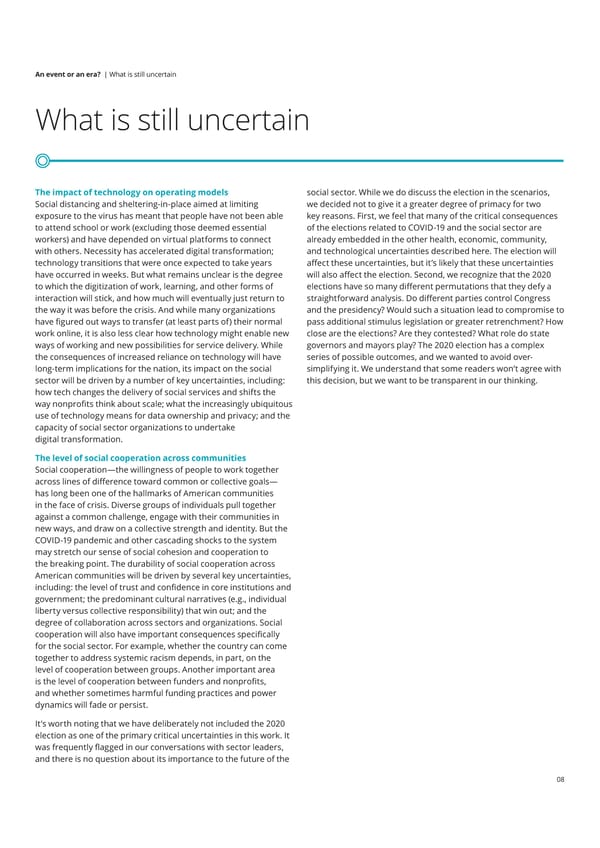An event or an era? | What is still uncertain What is still uncertain The impact of technology on operating models social sector. While we do discuss the election in the scenarios, Social distancing and sheltering-in-place aimed at limiting we decided not to give it a greater degree of primacy for two exposure to the virus has meant that people have not been able key reasons. First, we feel that many of the critical consequences to attend school or work (excluding those deemed essential of the elections related to COVID-19 and the social sector are workers) and have depended on virtual platforms to connect already embedded in the other health, economic, community, with others. Necessity has accelerated digital transformation; and technological uncertainties described here. The election will technology transitions that were once expected to take years affect these uncertainties, but it’s likely that these uncertainties have occurred in weeks. But what remains unclear is the degree will also affect the election. Second, we recognize that the 2020 to which the digitization of work, learning, and other forms of elections have so many different permutations that they defy a interaction will stick, and how much will eventually just return to straightforward analysis. Do different parties control Congress the way it was before the crisis. And while many organizations and the presidency? Would such a situation lead to compromise to have figured out ways to transfer (at least parts of) their normal pass additional stimulus legislation or greater retrenchment? How work online, it is also less clear how technology might enable new close are the elections? Are they contested? What role do state ways of working and new possibilities for service delivery. While governors and mayors play? The 2020 election has a complex the consequences of increased reliance on technology will have series of possible outcomes, and we wanted to avoid over- long-term implications for the nation, its impact on the social simplifying it. We understand that some readers won’t agree with sector will be driven by a number of key uncertainties, including: this decision, but we want to be transparent in our thinking. how tech changes the delivery of social services and shifts the way nonprofits think about scale; what the increasingly ubiquitous use of technology means for data ownership and privacy; and the capacity of social sector organizations to undertake digital transformation. The level of social cooperation across communities Social cooperation—the willingness of people to work together across lines of difference toward common or collective goals— has long been one of the hallmarks of American communities in the face of crisis. Diverse groups of individuals pull together against a common challenge, engage with their communities in new ways, and draw on a collective strength and identity. But the COVID-19 pandemic and other cascading shocks to the system may stretch our sense of social cohesion and cooperation to the breaking point. The durability of social cooperation across American communities will be driven by several key uncertainties, including: the level of trust and confidence in core institutions and government; the predominant cultural narratives (e.g., individual liberty versus collective responsibility) that win out; and the degree of collaboration across sectors and organizations. Social cooperation will also have important consequences specifically for the social sector. For example, whether the country can come together to address systemic racism depends, in part, on the level of cooperation between groups. Another important area is the level of cooperation between funders and nonprofits, and whether sometimes harmful funding practices and power dynamics will fade or persist. It’s worth noting that we have deliberately not included the 2020 election as one of the primary critical uncertainties in this work. It was frequently flagged in our conversations with sector leaders, and there is no question about its importance to the future of the 08
 US Deloitte Monitor Institute Page 7 Page 9
US Deloitte Monitor Institute Page 7 Page 9